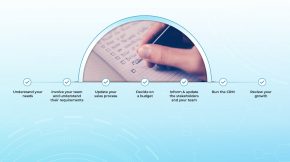Everything You Need to Know about PHP And its Frameworks
In the world of software applications, many technologies are available for web application development. Among the pool is PHP, one of the most demanding software applications. That is because PHP Frameworks helps in building web apps for many tech giants like Facebook and CMS (Content Management Systems) like WordPress, Drupal, Shopify, WooCommerce, etc. PHP accommodates even E-Commerce Platforms like Magneto and many more. PHP was among the first server-side languages that could be embedded into HTML, making adding functionality to web pages more comfortable without calling external files for data.
In this blog, let us understand PHP, its various frameworks, and the usage of PHP Frameworks.
What is PHP?
PHP Hypertext Preprocessor (PHP) is a famous general-purpose scripting language that suits the development of web-based software applications. Fast, adjustable, and practical, PHP can aid you in everything from your blog to the most attractive websites in the world.
Why PHP?
PHP started as a small open-source project that evolved as more people discovered how useful it was. Its use has developed over the years, with regular upgrades adding features and unlocking new capabilities. It’s open-source (and therefore free!); This helps developers get started with PHP – it can be installed quickly and at zero cost. There is also open access to many PHP frameworks, such as Laravel and Symfony. This feature also gains companies’ interest as it helps control web development costs.
Key advantages of working with PHP are:
- PHP is Platform Independent; it can run on all major operating systems like Windows, Linux, Unix, Mac OS X, etc. Also, almost all significant servers available today, like Apache, support PHP.
- PHP is a Server-Side Scripting language. It manages dynamic content, databases, session tracking, and even builds entire e-commerce sites.
- It is integrated with many popular databases, including MySQL, PostgreSQL, Oracle, Sybase, Informix, and Microsoft SQL Server.
- PHP is pleasingly zippy in its execution, mainly when compiled as an Apache module on the Unix side. The MySQL server, once started, executes even very complex queries with massive result sets in record-setting time.
- PHP supports many significant protocols such as POP3, IMAP, and LDAP. PHP4 adds support for Java and distributed object architectures (COM and CORBA), making n-tier development possible for the first time.
- PHP Syntax is C-Like.
- Five essential characteristics, i.e., Simplicity, Efficiency, Security, Flexibility, and Familiarity, make PHP’s practical nature possible.
- Organized, Easy integration, and consistency
- PHP also has many hash functions to encrypt users’ data, making PHP secure and reliable as a server-side scripting language.
What is a Framework?
A framework is a software engineering tool used by developers, coders, and programmers to create websites, apps, and IT systems. Developers and software engineers use a framework as a template to improve their work efficiency and quality.
Why are frameworks important?
The Framework plays a vital role for software professionals because –
- Frameworks often let software developers find bugs in their code.
- The Framework also helps developers finish their work more quickly.
- The Framework is often easier to maintain because professionals can adjust the code within the Framework at any time.
- Reduces costs by shrinking the time a professional spends programming the application.
Types of frameworks
Multiple types of Frameworks define themselves in the Software world based on their function or the primary coding language professionals add to it.
- Web app framework
- Mobile app framework
- Technology framework
- Enterprise architecture framework
- Database framework
- Testing framework
In the Open-Source Software World, PHP Frameworks come in the most demanding for any web application development as a part of a Web app and Technology framework.
Why is PHP Framework so popular for web applications?
The PHP programming language is a respected back-end technology for web development. Therefore, most PHP frameworks guide or provide a foundation to create web applications via code libraries for commonly used functions, cutting down on the amount of original code you need to write.
It speeds up and regularizes the development process, reducing doubts about how to start building an application.
There is also a chance of risk mitigation as opposed to coding the applications from scratch.
PHP Framework Types and Top 10 PHP Frameworks
Laravel is one of the more famous PHP frameworks packed with many features. These features include its propensity for scaling, elegant syntax, and design that favors progressive growth.
At the same time, Laravel is efficient for building complex applications. Its technical features like a template engine, routing, security, and authentication support this endeavor. Laravel is also expressive because it is easy to understand with little boilerplate (repeated) code.
Laminas Project, also known as Zend, is a ‘glue’ framework. It is component-based and is composed of three parts — components and MVC, Mezzio, and API tools. Mezzio empowers developers to build PHP Middleware and API tools to build Restful APIs.
Although Laminas Project uses a standard model-view-controller (MVC) software pattern, the Framework comes furnished with enterprise-ready PHP components, including event dispatchers, dependency injection, input validation, pagination, filtering, and more.
CodeIgniter is another popular PHP framework due to its simplicity, easy installation, and minimal configuration. The Framework also delivers quality error handling and easy-to-read documentation.
Slim is a PHP micro-framework alternative to full-stack frameworks that support only limited functionality. Generally, Slim is used to build RESTful APIs and web services.
Symfony is not just a framework, but it also carries a set of reusable PHP components and libraries. The reusable PHP components are always a great convenience that mitigates repetition in the coding process. Basically, Symfony was inspired by the Spring Framework, a Java micro framework that shares close similarities with Laravel, although it is a bit more complicated to begin with.
Features of Symfony, like its modular component system, database support, and debugging toolbar, entice PHP developers to the Framework for building APIs, microservices, web applications, and web services.
Phalcon (“PHP” and “falcon”) is a full-stack framework. The more unique features of Phalcon are its code compilation, low-level architecture, security protections, memory management, and absence of file reads — resulting in improved performance.
FuelPHP is a PHP framework that is Fast, Simple, and Flexible and uses a hierarchical variation of the MVC that ‘widgetizes’ content structures. The advantages of this distinctive design involve improved modularity and extensibility, along with more suitable code reusability and organization.
Security in FuelPHP is also notoriously superb, with features that encompass cross-site request forgery (CSRF) protection, output encoding and filtering for inputs, uniform resource identifiers (URIs), and cross-site scripting (XSS).
PHPixie employs a hierarchical model-view-controller (MVC) architecture similar to FuelPHP. PHPixie was built using independent components that warrant good modularity with little dependencies. The Framework promises high performance, ease of use, and low coupling, among other things.
CakePHP is a fast-development PHP framework modeled after Ruby on Rails that involves minimal configuration, making the Framework effortless to install and straightforward to use. In addition, CakePHP has a thorough assortment of libraries with valuable components. The Framework also has various security features like encryption, password hashing, and CSRF protection.
Yii is a suitable choice for beginners to PHP. Besides an MVC architecture, some of Yii’s elements include the unit and functionality testing, error handling, security measures such as CSRF and XSS, and a layered caching system.
How To Choose the Right PHP Frameworks?
When choosing the proper PHP Framework, it’s tough to choose among various PHP Framework offer many advantages.
In general, Frameworks like Phalcon and Laravel, for example, are well-suited for large and complex applications. On the other hand, frameworks like Symfony and Slim are optimal for businesses that want to start small, though scaling is an option. CodeIgniter is as powerful as many frameworks but with little configuration.
So, in short, it depends on the type of Business Requirement and the professional software developer’s conclusion based on that.
Nowadays, Symfony and Laravel are the most widely used Framework compared to the other PHP Frameworks. But, developers prefer Laravel mainly for its fast development, performance, and high speed. In contrast, Symfony is suitable for effortlessly developing complex and large-size web applications.
Also, Laravel has the best Object-relational Mapper in comparison with other frameworks. This lets you interact with your database relationships and objects using expressive syntax. Laravel comes with an inbuilt template engine known as Blade Template Engine.
Additionally, Laravel has a better approach and thus is preferable to CakePHP in terms of data backup and handling perspective. CakePHP mainly works on smaller projects and thus is less preferable from a data backup and handling perspective.
Benefits of using PHP Frameworks
- The MVC Pattern: Model-View-Controller Architectural Pattern allows you to manage your code for easy maintenance. By keeping data-manipulating logic separated from the bits that handle the display, you make it comfortable to modify the template or the underlying code without handling the other.
- Bundled classes: One Framework contains essential functions and classes for everyday tasks, such as pagination, form handling, and database access. Not to cite the little things, such as squashing the text of a distinct character/word count.
- Faster development: Frameworks allow you to build a small, medium-sized app quicker than if you wrote everything from the beginning. If you are in a rush, using Framework will help you achieve the things before that time passes.
- Good Coding Standard: Another result of using a Framework is to maintain the coding standard efficiently. The coding pattern is a set of guidelines for a specific programming language that recommends programming styles, practices, and methods. Using a framework makes it easy to code as much as possible.
- Access Databases Efficiently: A Framework equips a method to access the database in an object-oriented manner, rather than interacting instantly with the database using SQL queries.
- Security: The PHP framework with built-in tools and features makes it easy to guard web applications from external and safety hazards. Security hazards can be SQL injection, forgery, data manipulation, etc. To bypass these security threats, developers used a PHP framework to develop web applications.
Final Note
PHP frameworks are an excellent approach for PHP programmers to reduce repetitious writing, speed up the development process, and assure good coding when developing online applications.
PHP frameworks make creating small and large apps easier while ensuring that your code is secure. PHP frameworks are diverse, and programmers choose frameworks based on their requirements. Laravel, Codelgniter, Yii 2, Zend Framework 2, and CakePHP are some of the most popular PHP frameworks today.
You should always be aware of the most recent advances in the world of web development.












